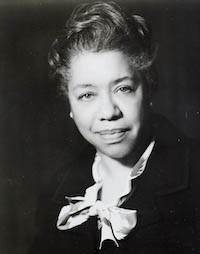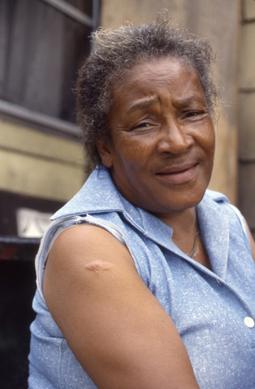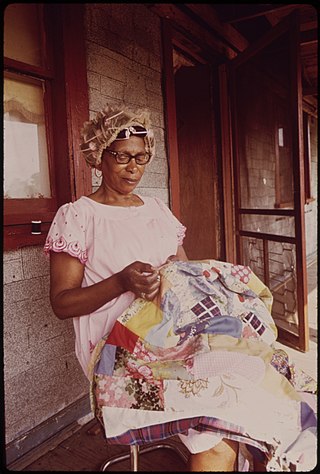Related Research Articles

Toni Cade Bambara, born Miltona Mirkin Cade, was an African-American author, documentary film-maker, social activist and college professor.

Jean Ruth Ritchie was an American folk singer, songwriter, and Appalachian dulcimer player, called by some the "Mother of Folk". In her youth she learned hundreds of folk songs in the traditional way, many of which were Appalachian variants of centuries old British and Irish songs, including dozens of Child Ballads. In adulthood, she shared these songs with wide audiences, as well as writing some of her own songs using traditional foundations.

Augusta Braxton Baker was an American librarian and storyteller. She was known for her contributions to children's literature, especially regarding the portrayal of Black Americans in works for children.
Alice McGill is an American children's writer and professional storyteller. Many of her books have African American protagonists or deal with African American issues. Molly Bannaky, the story of a young British girl in 17th century America who became the grandmother of Benjamin Banneker, the first black man to publish an almanac, was an ALA Notable Book and winner of the 2000 IRA Picture Book Award and the 2000 Jane Addams Award.
Edmund Lenihan, known as Eddie Lenihan, is an Irish author, storyteller, lecturer and broadcaster. He is one of the few practising seanchaithe remaining in Ireland. He has been called "one of the greatest of Irish story-tellers", "a national treasure" and an "absolute legend."

Sheila Kay Adams is an American storyteller, author, and musician from the Sodom Laurel community in Madison County, North Carolina.
Margaret H. Lippert is an American author of books and anthologies drawing from the folklore and storytelling traditions of cultures from around the world.

Nancy Sweezy was an American artist, author, folklorist, advocate, scholar, and preservationist. Known initially for her work as a potter in the 1950s, Sweezy became a scholar of the history and creation of pottery and wrote several authoritative texts and books on U.S. and international folk pottery. She was a major figure in the establishment of markets for folk and traditional crafts. Other major accomplishments in her extensive career included the founding of the crafts organization Country Roads, the revival of North Carolina's historic Jugtown Pottery, and the creation of the Refugee Arts Group in Massachusetts for immigrant folk artists. Her advocacy work also included developing apprenticeship programs. She also was involved with Club 47, a famous performing scene in the American folk music revival.

Helen Cordero was a Cochiti Pueblo potter from Cochiti, New Mexico. She was renowned for her storyteller pottery figurines, a motif she invented, based upon the traditional "singing mother" motif.

Mary Louise Defender Wilson, also known by her Dakotah name Wagmuhawin, is a storyteller, traditionalist, historian, scholar and educator of the Dakotah/Hidatsa people and a former director working in health care organizations. Her cultural work has been recognized with a National Heritage Fellowship in 1999 and a United States Artists fellowship in 2015, among many other honors.

Bessie Harvey was an American artist best known for her sculptures constructed out of found objects, primarily pieces of wood. A deeply religious person, Harvey's faith and her own interest in nature were primary sources for her work.

Suni Paz is an Argentinian singer, songwriter, guitarist, poet, folklorist, translator, and teacher, who has recorded and has been published extensively. Paz is part of the progressive Latin American music movement known as nueva canción.
May Justus was an American author of numerous children's books, almost all of which were set in Appalachia and reflect the traditional culture of her native East Tennessee. She also worked as a teacher and served for many years as volunteer secretary-treasurer for the Highlander Folk School.
Roland L. Freeman was an American photographer and documenter of Southern folk culture and African-American quilters. He was the president of The Group for Cultural Documentation, founded in 1991 and based in Washington, D.C.
Becky Birtha is an American poet and children's author who lives in the greater Philadelphia area. She is best known for her poetry and short stories depicting African-American and lesbian relationships, often focusing on topics such as interracial relationships, emotional recovery from a breakup, single parenthood and adoption. Her poetry was featured in the acclaimed 1983 anthology of African-American feminist writing Home Girls: A Black Feminist Anthology, edited by Barbara Smith and published by Kitchen Table: Women of Color Press. She has won a Lambda Literary award for her poetry. She has been awarded grants from the Pew Fellowships in the Arts, the National Endowment for the Arts and the Pennsylvania Council on the Arts to further her literary works. In recent years she has written three children's historical fiction picture books about the African-American experience.
Annie Christmas or flatboat Annie is a character in the folklore and tall tales of Louisiana, described as a 7 feet (2.1 m) tall, supernaturally strong African-American woman keelboat captain. She has been described as a female counterpart of the John Henry character, another supernaturally strong African American folklore character. Like John Henry, the character may have been based on a real person. Stories of Annie Christmas have been included in several collections of folktales from the Southern United States.

Janie Hunter was an American singer and storyteller who worked to preserve Gullah culture and folkways in her home of Johns Island, South Carolina. She received a 1984 National Endowment for the Arts National Heritage Fellowship in recognition of her contributions to folk art and traditions.
Susan Snow Wadley is an American anthropologist.
Joan Newlon Radner is an American folklorist, storyteller and oral historian. She is Professor Emerita at American University in Washington, DC.
Betsy Whyte, née Townsley (1919-1988), was a Scottish traveller. She was an accomplished singer and a noted virtuoso of traditional Scottish storytelling. Recordings of her performances are held in the permanent collection of the School of Scottish Studies, part of the University of Edinburgh. She wrote her autobiography in two parts: Yellow on the Broom, published in 1979, and its sequel, Red Rowans and Wild Honey, published posthumously in 1990.
References
- 1 2 Abdul-Malik, Karen "Queen Nur" (n.d.). "Linda Goss: African-American Storyteller". www.arts.gov. National Endowment for the Arts. Retrieved February 25, 2021.
- 1 2 3 4 5 6 7 8 9 10 11 12 13 Tucker, Melanie (June 25, 2019). "Alcoa native wins prestigious national storytelling fellowship". The Daily Times. Maryville, Tennessee. Retrieved February 26, 2021.
- ↑ "Linda Goss: A Biographical Sketch of our Co-Founder" (PDF). National Association of Black Storytellers. n.d. Retrieved February 26, 2021.
- ↑ "Goss, Linda". loc.gov. Library of Congress. August 14, 1992. Retrieved February 26, 2021.
- 1 2 Tucker, Melanie (August 17, 2018). "Where I come from: Goss returns to community she holds deep in heart, stories". The Daily Times. Maryville, Tennessee. p. 11A. Retrieved February 26, 2021.
- 1 2 3 4 5 6 7 8 9 10 11 Kelley, Saundra Gerrell, ed. (2011). "Linda Goss". Southern Appalachian Storytellers: Interviews with Sixteen Keepers of the Oral Tradition. McFarland. pp. 120–137. ISBN 9780786447510. OCLC 635492303.
- 1 2 3 4 5 6 7 8 9 10 11 12 Miller, Corki; Snodgrass, Mary Ellen, eds. (1998). "Linda McNear Goss" . Storytellers: A Biographical Directory of 120 English-Speaking Performers Worldwide. Jefferson, North Carolina: McFarland. pp. 121–125. ISBN 9780786404704. LCCN 97-49075. OCLC 38105260.
- 1 2 Wilson, Kendall (February 26, 1980). "It's how she tells the story that makes Linda Goss unique". Philadelphia Tribune. Philadelphia, Pennsylvania. p. 9.
- 1 2 3 4 5 Kodish, Debora (Fall 2013). "Cultivating Folk Arts and Social Change". The Journal of American Folklore. 126 (502): 434–454. doi:10.5406/jamerfolk.126.502.0434. ISSN 0021-8715. JSTOR 10.5406/jamerfolk.126.502.0434. S2CID 145139238.
- 1 2 3 "Linda Goss". Philadelphia Folklore Project. Retrieved June 10, 2020.
- ↑ Goss, Linda (1984). Storytelling in the Tradition. interviewed by Judy Moore Smith. Washington, D.C.: National Public Radio. LCCN 88-740394. OCLC 21678723. HO-840201.
- 1 2 Tucker, Melanie (January 18, 2005). "Once upon a time: Alcoa woman returns home to tell her stories". The Daily Times. Maryville, Tennessee.
- 1 2 Ferguson, Eve M. (September 11, 2019). "Baltimore Storyteller Among 2019 Class of NEA National Heritage Fellows". The Washington Informer. Retrieved June 6, 2020.
- ↑ Goss, Linda; Goss, Clay (1989). The Baby Leopard: A 'How' and 'Why' Story. illustrations by Suzanne Bailey-Jones and Michael R. Jones. New York: Bantam. ISBN 9780553346480. LCCN 89-17572. OCLC 20055569.
- ↑ Goss, Linda; Barnes, Marian E., eds. (1989). Talk That Talk: an Anthology of African-American Storytelling . New York: Simon & Schuster. ISBN 9780684810904. LCCN 95-22008. OCLC 32746142.
- ↑ Goss, Linda; Goss, Clay, eds. (1995). Jump Up and Say! A Collection of Black Storytelling . New York: Simon & Schuster. ISBN 9780671671686. LCCN 89-10582. OCLC 20056687.
- ↑ Goss, Linda; Goss, Clay (1995). It's Kwanzaa Time! . illustrations by Ashley Bryan. New York: G.P. Putnam's. ISBN 9780399225055. LCCN 92-30380. OCLC 26542625.
- ↑ Goss, Linda (1995). The Frog Who Wanted to be a Singer. illustrations by Cynthia Jabar. New York: Orchard Books. ISBN 9780531068953. LCCN 94-48803. OCLC 31938588.
- ↑ Goss, Linda; Pritchett, Dylan; Reed, Caroliese Frink, eds. (2006). Sayin' Somethin': Stories from the National Association of Black Storytellers. Baltimore, Maryland: National Association of Black Storytellers. ISBN 9780977936618. OCLC 76789524.
- ↑ Pearson, P. David (1989). On the Horizon. consulting authors, Carl Grant, Jeanne Paratore. Needham, Massachusetts: Silver Burdett & Ginn. ISBN 9780663461219. OCLC 20487532.
- ↑ Anderson, Robert (1989). Elements of Literature. Austin, Texas: Holt, Rinehart and Winston. ISBN 9780157175202. OCLC 18784049.
- ↑ Justice, Jennifer, ed. (1992). The Ghost & I: Scary Stories for Participatory Telling . Cambridge, Massachusetts: Yellow Moon Press. pp. 13–18. ISBN 9780938756378. LCCN 98-151851. OCLC 26937779.
- ↑ Selected and arranged by Carol Birch (1993). A Storytelling Treasury (CD). Vol. 3. Jonesborough, Tennessee: National Storytelling Press. ISBN 9781879991255. OCLC 54019420. NAPPS 10.
- ↑ Woods, Paula L.; Liddell, Felix H., eds. (1994). I Hear a Symphony: African Americans Celebrate Love (1st Anchor Books ed.). New York: Anchor Books. pp. 230–234. ISBN 9780385475020. LCCN 94-6742. OCLC 29909384.
- ↑ Livo, Norma, ed. (1995). Joining In: An Anthology of Audience Participation Stories & How to Tell Them. compiled by Teresa Miller with assistance from Anne Pellowski. Cambridge, Massachusetts: Yellow Moon Press. pp. 9–18. ISBN 9780938756217. LCCN 98-207900. OCLC 18895434.
- ↑ Goss, Linda (1980). Afro-American Folktales and Playsongs (LP). New York: Folkways. OCLC 7429064. FCS 77865.
- ↑ Goss, Linda (2003). Afro-American Folktales & Playsongs (CD). Washington, D.C.: Smithsonian Folkways. OCLC 465186642. FCS 77865.
- ↑ Goss, Linda (1983). It's Story Telling Time (LP). New York: Folkways. LCCN 85-750602. OCLC 12917233. FC 77861.
- ↑ Goss, Linda (2001). It's Story Telling Time (CD). Washington, D.C.: Smithsonian Folkways. OCLC 48714467. FCS 77861.
- ↑ Goss, Linda; Goss, Clay (1989). The Baby Leopard (cassette tape). New York: Bantam Audio. ISBN 9780553459111. OCLC 20791957. 45911.
- ↑ Goss, Linda (1993). African Tales and Games (cassette tape). Washington, D.C.: Folkways. OCLC 156038670. 77865.
- ↑ "NEA National Heritage Fellowships 2019". www.arts.gov. National Endowment for the Arts. n.d. Retrieved February 25, 2021.
- ↑ "Mama Linda's Chapbook: Songs and Poems from the Peale's Storyteller-in-Residence". The Peale Center. n.d. Retrieved February 26, 2021.
- ↑ Edmonds, Arlene (April 29, 2016). "'Movers and Shakers' among women of faith honored at ceremony". The Review. Roxborough, Pennsylvania. Retrieved February 28, 2021.
- ↑ Shamlin III, Wilfrid (June 9, 2013). "Master storyteller recognized for lifetime work". Philadelphia Tribune. Philadelphia, Pennsylvania. p. 3A. Retrieved February 28, 2021.